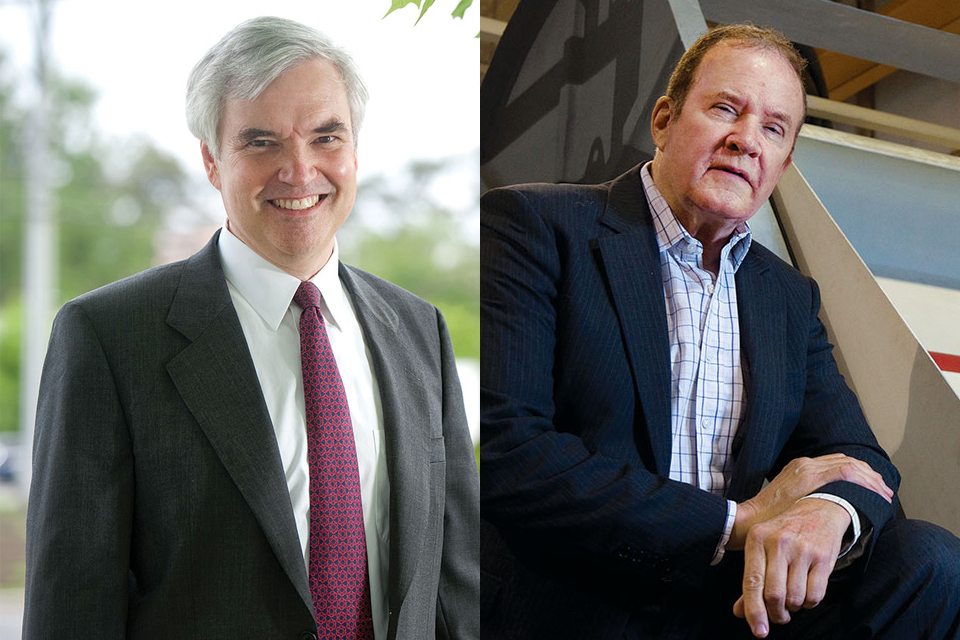Capital Context: Clean Technology – The Future is Now

BRIAN FOODY President and CEO of Iogen. FRED FERGUSON CEO and CTO of Waterotor
Ottawa companies have already blazed different trails
By Leo Valiquette
With a world-leading technology sector and a growing need to be ready for a low-carbon future, where does Ottawa stand on the cleantech spectrum? According to Invest Ottawa, our city is home to more than 240 clean tech companies that employ more than 5,300 people. Clean tech is old hat for some of those companies, while others are just getting started. The good news is that the opportunities are growing.
Iogen Corporation and Waterotor Energy Technologies are both making waves in global markets with sustainable solutions to pressing environmental issues, and show that Ottawa is well established as a place where clean tech can thrive.
Ending our addiction to fossil fuels
Since 1986, Iogen has pioneered cellulosic technology, to create renewable biofuels from agricultural and household organic waste and wean us from our addiction to fossil fuels. Key to Iogen’s success has been coupling innovation with global partnerships. Today it has a $12-billion joint venture in Brazil, called Raizen, to convert sugar cane waste into biofuel.
Cellulosic biofuel could replace over 30 percent of U.S. petroleum consumption for transportation, and reduce greenhouse gas emissions by up to 90 percent compared to gasoline. Iogen is on track to become the number two producer in the world.
While the biofuel industry suffered a setback with the 2008 financial crisis and the subsequent collapse of global oil prices, Iogen president and CEO Brian J. Foody remains bullish on his industry’s outlook over the next decade. “I would see these kinds of fuels being able to penetrate maybe 10 percent of the U.S. market—that’s more than Canada’s entire gasoline consumption,” he says. “We will see improvements in technology, we will see access to new feedstocks and I think we are going to see a lot of growth.”
But success hinges on two things: the United States maintaining its commitments to renewable fuels, and Canada’s federal and provincial governments moving ahead with plans to develop new standards for low-carbon fuels that will help expand their use.
Reinventing hydro-electric power
At Waterotor, CEO and CTO Fred Ferguson is also hoping to remake the world with a green solution that has been decades in the making. You may remember him as the man behind the Magnus Spherical Airship in the 1980s. The design featured a large, round, helium-filled sphere that rotated backward as the airship flew forward, producing lift.
In the 2000s, Ferguson repurposed the same concept to create Magenn Air Rotor Systems (MARS). These tethered “floating generators” rotated in response to wind to generate electricity.
But it’s difficult to generate economically feasible power from wind. Water, on the other hand, contains 830 times more energy than wind.
With Waterotor, Ferguson and his team have developed and validated a design that can generate consistent power around the clock from a regular flow of water in a stream, river or lake moving as slow as three kilometers per hour (kph). That means almost any slow moving body of water can become an economical power source. Other competing technologies need a water flow of at least 9.5 kph.
It’s a huge market opportunity Waterotor is well-positioned to dominate thanks to sound engineering, strong patents, and a compelling value proposition. A 20-kilowatt Waterotor unit, with the cost amortized over 10 years, can generate power at a cost of only 5 cents per kilowatt hour (kWh). Compare that to wind, which costs from 6.5 to 21 cents per kWh, according to Ontario’s Independent Electricity System Operator.
Orders have already come in from the United States and Waterotor is also in talks overseas. The Indonesian government, for example, wants 100,000 units to wean its fishing industry off a dependence on gasoline generators for refrigeration.
“Things are really moving ahead,” Ferguson says. “By this time next year, I expect at least one major manufacturer to have bought into this company.”
As other companies pursue a future in the clean tech sector, for some firms the future is already here, and they’re making the most of it.
Leo Valiquette is a freelance writer and marketing communications/media relations consultant who lives in Stittsville. He is the former editor of the Ottawa Business Journal.
5 Keys to Make Ottawa a Global Leader in Clean TechInnovation
Global partnerships
Sound engineering
Strong patents
Compelling value proposition
 Renewable Returns
Renewable Returns
Clean energy projects offer
a different way to invest
By Matt Curtis
An increasing number of savvy investors are turning to renewable energy to generate a healthy return on their investments. For organizations like the Ottawa Renewable Energy Co-op (OREC) and Lumos Clean Energy Advisors, that’s good news for the environment and their bottom line.
OREC is a solar-focused renewable energy co-operative with a community-owner model that developed in response to demand for local green-energy investment opportunities. Since 2012, OREC has attracted more than 700 members, who are eligible to purchase securities that are used to fund OREC’s solar projects. Its fifth and most recent investment offering, which closed in April this year, generated $1.99 million.
“Every dollar invested in community power projects generates up to two dollars on a province-wide level,” said OREC general manager Janice Ashworth. “Profits are distributed locally to members proportionate to their investment so all of the earnings stay in Eastern Ontario.”
OREC enters into 20-year lease agreements with partnering property owners to install solar renewable energy systems on their land or rooftops. Once the projects are in place, electricity is sold to the grid through Ontario’s Feed-in Tariff program, which provides a guaranteed rate for each kilowatt-hour (kWh) of electricity produced. This allows OREC to repay members, and offer a healthy return on investment.
OREC currently has 13 projects on the tops of schools, non-profit housing, and private warehouses and barns around the city, and four new projects are expected to start generating power in June. Its generating capacity will reach 1.7 MW by the end of summer 2017, which will place OREC among the top five largest renewable energy co-ops by generating capacity. There are currently 96 co-ops in Ontario, taking on an increasing diversity of projects.
Ashworth—who was honoured this year with a Forty Under 40 award from the Ottawa Chamber of Commerce and the Ottawa Business Journal—is especially proud of OREC’s project at Maurice Lapointe School in Kanata. The 190 kW rooftop solar array, which marked Ottawa’s 1000th solar installation—was installed for $745,000 using Ontario-made equipment and local labour and is expected to generate $120,000 in revenues to the school and produce nearly 260,000 kWh per year.
Ottawa-based Lumos Clean Energy Advisors also works with communities, providing advice on how to form partnerships with clean energy developers, utilities, and finance firms. With a focus on advising First Nations, Metis, and Inuit groups, Lumos aims to build capacity for self-reliance within Indigenous communities.
“[Communities] are looking for expertise on what’s fair, what makes sense, and how to make projects happen,” says Lumos president Christopher Henderson, who takes a holistic, long-term approach to the company’s work. “We almost act like a merchant bank, where our returns occur when the First Nations get their returns.”
Interest in the field is growing, and so is the demand for expertise. Last year, Lumos introduced a training program that Henderson calls a “clean energy intensive MBA for Indigenous communities.” This three-month intensive program is aimed at young Indigenous people to help them realize the benefits of renewable energy and build skills in the field.
 Finding a Greener Way to Do Business
Finding a Greener Way to Do Business
At Your Credit Union, the business of the day isn’t clean energy, but financial services. Still, this local institution, which serves about 11,000 members in Ottawa and Cornwall, is doing its part for a healthier planet.
One of the first steps YourCU took was to join Carbon613. This initiative of the EnviroCentre helps member organizations access programs and services to help them set emission reduction targets. YourCU’s goal is to reduce its carbon footprint by 20 percent over 10 years.
YourCU is working to achieve this goal by partnering with clean energy supplier BullFrog Power for electricity and natural gas at all six of its branches.
President and CEO Joel Lalonde is a big supporter of greener practices—he drives an electric car and his home is also powered by Bullfrog. But while it was management that decided to put YourCU on this path, the entire organization has embraced it.
“It was exciting to see how onboard the staff were,” he said. “It is very much a shared commitment.”
What is his advice to other businesses looking to make a positive difference?
“Keep it simple first and foremost,” he said. “This isn’t part of our core business, but it is obviously important to our legacy.”






















